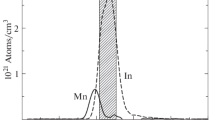Abstract
The method of superconducting quantum interference device (SQUID) magnetometry is used to measure and study low-temperature (T ≤ 100K) susceptibility in a series of samples of heavily doped Ge:As samples on the insulator side of the insulator–metal phase transition. Subtracting the known values of the magnetic susceptibility of the lattice from the measurement results, the values of the impurity magnetic susceptibility of the system are obtained. Using the method of electron spin resonance, the paramagnetic component of the impurity susceptibility is determined. Subtraction of the paramagnetic component from the total impurity susceptibility is used to obtain, for the first time, the values of the impurity diamagnetic susceptibility (~5 × 10–8 cm3/g). The obtained result is consistent with estimates obtained for the localization radius of an electron at an As donor. Lowering the temperature to T ≤ 4 K leads to an increase in the diamagnetic susceptibility, which is consistent with the observed increase in the paramagnetic susceptibility. The observed effect is accounted for by the transition of impurity electrons from the singlet state to the triplet one.
Similar content being viewed by others
References
S. V. Vonsovskii, Magnetism (Nauka, Moscow, 1971; Wiley, New York, 1971).
D. K. Stevens, J. W. Cleland, J. H. Crawford, and H. C. Schweinler, Phys. Rev. 100, 1084 (1955).
A. I. Veinger, A. G. Zabrodskii, T. V. Tisnek, and S. I. Goloshchapov, Semiconductors 41, 790 (2007).
A. I. Veinger, A. G. Zabrodskii, T. V. Tisnek, and S. I. Goloshchapov, Semiconductors 42, 1274 (2008).
A. G. Zabrodskii and K. N. Zinov’eva, Sov. Phys. JETP 59, 425 (1984).
G. W. Ludwig and H. H. Woodbury, Solid State Physics, Ed. by F. Seitz and D. Tumbull, Vol. 13 (Academic Press, New York, 1962; Mir, Moscow, 1964).
F. J. Dyson, Phys. Rev. 98, 349 (1955).
G. Feher and A. F. Kip, Phys. Rev. 98, 337 (1955).
A. I. Veinger, A. G. Zabrodskii, T. V. Tisnek, S. I. Goloshchapov, and P. V. Semenikhin, Tech. Phys. 58, 1806 (2013).
M. V. Alekseenko, A. G. Zabrodskii, and L. M. Shterengas, Semiconductors 32, 720 (1998).
A. I. Veinger, A. G. Zabrodskii, T. L. Makarova, T. V. Tisnek, S. I. Goloshchapov, and P. V. Semenikhin, J. Exp. Theor. Phys. 116, 706 (2013).
H. Kamimura, in Crystalline Semiconducting Materials and Devices, Ed. by P. N. Butcher, N. H. March, and M. Tosi (Plenum, New York, 1986).
Author information
Authors and Affiliations
Corresponding author
Additional information
Original Russian Text © A.I. Veinger, A.G. Zabrodskii, T.L. Makarova, T.V. Tisnek, S.I. Goloshchapov, P.V. Semenikhin, 2015, published in Fizika i Tekhnika Poluprovodnikov, 2015, Vol. 49, No. 10, pp. 1339–1345.
Rights and permissions
About this article
Cite this article
Veinger, A.I., Zabrodskii, A.G., Makarova, T.L. et al. Detection of impurity diamagnetic susceptibility and its behavior in n-Ge:As in the region of the insulator–metal phase transition. Semiconductors 49, 1294–1301 (2015). https://doi.org/10.1134/S1063782615100267
Received:
Accepted:
Published:
Issue Date:
DOI: https://doi.org/10.1134/S1063782615100267




